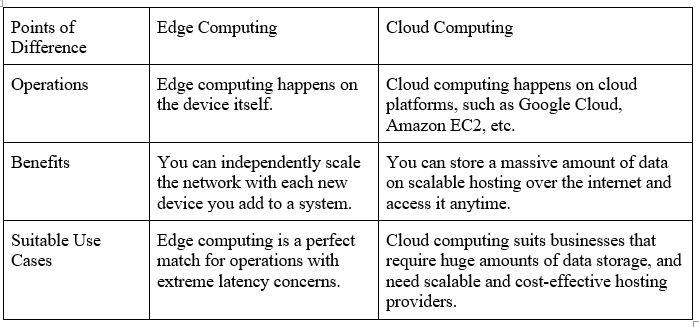The concept of edge computing is nothing but computing in a very distributed environment. This consists of storage and computing power closer to the computer where it is quite essential for the sources of information. When it comes to cloud computing, data is routed via scattered data centers, but the data is not scanned; rather the cloud comes as an aid to everyone. There is a significant saving in the storage space and lag time.
If we compare to IOT technology, edge computing can be used as an alternative method for the computing fraternity. This is all about having access to the real-time data, extremely close to the source of data, which is called the channel’s “edge”. Instead of having a consolidated cloud or a database server or for that a data storage place, it is all about having virtual machines in closer proximity to the place where data is generated.
For instance, in the case of a vehicle measuring the consumption of fuel, there are sensors that provide data and then there are sensors that are dependent exclusively on the data provided. The machine that is executing this program is known as an edge computing system or in literal terms – an edge device. Since we can observe this shift in the procurement of data and management of it, we will look into the details of these two computing techniques and also delve into some of the merits that each of these techniques has to provide.
What is edge computing?
By using a unified computing infrastructure along with a transmission channel, various computing resources and communication technologies can be easily deployed. This is possible only because of edge computing. By leveraging the use of edge computing, enterprises can easily accomplish the requirements around computing.
Through edge computing, whenever there is a necessity to gather information or for a particular user to execute a specific activity, the same can be done on a real-time basis. If we want to know the major advantages of edge computing, thenenhanced efficiencyandreduction in operational costsare the two primary ones that are associated with edge computing. However, let us look at some of the other benefits of edge computing as well.
(Read to Know More: What is Edge Computing? – All You Need to Know)

Advantages of edge computing
Use cases of Edge Computing
There are multiple examples where edge computing is used, however, the three main areas where edge computing is used extensively is
What is Cloud Computing?
A simple definition of cloud computing is the utilization of different users via the internet. These resources include application development frameworks, storage systems, servers and other software as well.
There are three major features that any cloud service provider will deliver.
(Read to Know More: Cloud Computing | Ultimate Guide for Beginners)
Service Models of Cloud Computing
From a market standpoint, cloud computing models can be deployed in different types, depending on the requirement. The different services models of cloud computing are:
Deployment models in cloud computing
Like virtualization techniques, cloud computing also has a set of prerequisites that are needed for a successful deployment. There are majorly four types of deployment models in cloud computing.
Advantages of Cloud Computing
While we did talk about some challenges posed by cloud computing, earlier in this article, however, there are some key benefits that the model delivers.
Difference between Edge Computing & Cloud Computing
Now that we have seen what these two computing methodologies have to deliver, let us do a quick comparative check to see the disparity between the two.
| Factors of differentiation | Edge Computing | Cloud Computing | |
|---|---|---|---|
| Programming | Multiple application programs may be running at different types at the time of development. | The Cloud computing model utilizes a single programming language for the specific development of applications on cloud platforms. | |
| Security | This requires a very exhaustive and comprehensive security standard, with sophisticated authentication methodologies. | Cloud computing does not require extensive security. | |
| Relevant organizations | Applications that have a considerable bandwidth issue can go for edge computing making it a viable and optimum option | Any application that is involved in a large amount of data processing can be done through cloud computing. | |
| Operations | The process of computing happens on the system itself. Mostly on the system itself, edge computing occurs. | Here, the storage of applications takes place on the cloud server, such as Amazon EC2 or Google Cloud. | |
| Advantages | A new machine can be linked to a network by building the network. | A large chunk of data can be stored on the cloud server and then accessed via the internet. |








